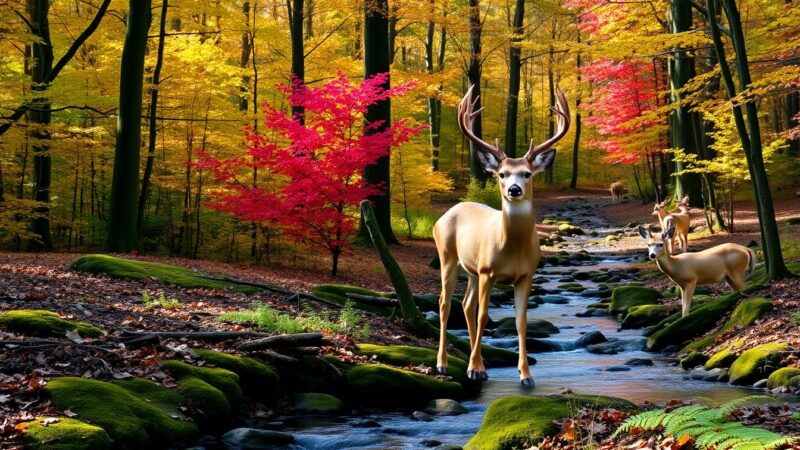Deer Life Cycle in Massachusetts: Understanding Their Seasonal Patterns and Habitat Needs

Introduction
Deer are a common sight in Massachusetts’s forests, suburbs, and rural areas. These animals are not just part of our landscapes; they hold ecological and cultural importance. Managing deer populations means knowing their habits and how they change throughout the year. That’s where understanding the deer life cycle becomes essential. Massachusetts’s diverse habitats, from dense woods to open fields, shape how deer grow, breed, and survive.
The Deer Life Cycle in Massachusetts: An Overview
Most deer in Massachusetts are white-tailed deer, known for their adaptability. Their life cycle consists of several key stages: birth, growth, reproduction, and aging. Each phase is tied closely to the seasons, with environmental cues guiding their behavior. Knowing these stages helps protect deer and keep human-deer interactions safe and balanced.
Spring: Birth and Neonatal Care
Fawning Season in Massachusetts
Spring marks the start of fawning in Massachusetts, usually from April to June. The timing depends on food availability and weather conditions. Warm days and plentiful plants help fawns thrive. During this period, many young deer are born, and survival rates depend on factors like predators and habitat quality.
Neonatal Deer (Fawns) Characteristics
Fawns are tiny when born, typically weighing about 6-8 pounds. They sport soft, spotted coats that help hide them. Fawns are vulnerable to predators such as coyotes, foxes, and humans. People exploring woods should watch out for these delicate newborns and avoid touching or disturbing them.
Habitat Needs for Newborns
Fawns need thick cover to hide from predators. They prefer dense shrubs, forest edges, and tall grass. These habitats offer safety and access to fresh leaves, stems, and grasses, which are vital for their growth. Protecting these areas ensures better chances of survival for newborns.
Summer: Growth and Development
Fawn Development
By summer, fawns begin to grow fast. They start weaning off milk and eating plants like leaves and twigs. This stage is critical — fawns learn how to find food and escape danger. They become more independent, but still stay close to their mothers.
Deer Behavior in Summer
Deer become more active during summer, especially during dawn and dusk. They spend more time foraging in open areas. Doe groups, called herds, provide safety, while young bucks begin sparring and practicing scent marking.
Impacts of Summer Food Availability
Spring’s abundance of acorns, hickory nuts, and shrubs fuels deer growth. Good food sources help them build fat reserves for the colder months. Heavy rain or drought can change food availability, making deer either thrive or struggle to find enough nourishment.
Fall: Rut and Maturity
Rutting Season in Massachusetts
Fall is the showtime for deer mating, called the rut. It happens from October to early December. Male deer, or bucks, become more active and territorial. They rub tree bark with their antlers to mark their territory and attract females.
Reproduction and Fawning Preparation
Does usually come into heat in late fall. During this time, bucks roam more widely, seeking mates. After mating, females prepare for another round of fawning next year, often within a similar spring window.
Habitat Use During Rut
During rut, deer move more, crossing roads and exploring new areas. Buck behavior includes sparring with other males to win mates. Landowners and outdoor enthusiasts should be cautious and respectful of deer during this busy season.
Fawn Births and Early Survival
Following fall, some does give birth to their fawns late in spring or early summer. To improve fawn survival, minimize disturbances in deer habitats and avoid high-traffic areas during peak birthing times.
Winter: Survival, Aging, and Adaptation
Deer Adaptation to Winter Conditions
Deer grow thicker coats and gain body fat to stay warm. They slow down and move less, relying on stored energy. They often stay close to food sources like evergreen shrubs and bark.
Challenges Faced During Winter
Snow and ice make it harder for deer to find plants. Cold temperatures can drain their energy, especially if food is scarce. Predators may also take advantage of deer’s reduced activity during storms.
Aging and Mortality
Deer naturally age around 6-10 years in Massachusetts. Many die from winter hardships, accidents, or predation. Aging deer show signs like worn teeth or thinning coat, indicating they’re nearing the end of their lives.
Human Influence and Management
Some people feed deer during harsh winters, but it needs to be done carefully. Managing deer populations with hunting and habitat improvements helps reduce overpopulation and vehicle crashes. Responsible management supports healthy populations year-round.
Conservation, Management, and Human-Deer Interactions
Current Status of Deer Populations in Massachusetts
Massachusetts has stable deer populations in many areas, with estimates around 200,000 animals. They thrive in parks, forests, and even suburban neighborhoods. Conservation efforts focus on preserving habitats and reducing conflicts.
Managing Deer Populations
Approaches include controlled hunting, habitat management, and planting deer-safe landscaping. These methods help prevent overpopulation, which can lead to car accidents and damage to plants.
Educating the Public
Public awareness is key to peaceful coexistence. Residents and visitors should observe deer from a safe distance, avoid feeding them, and report issues to local wildlife agencies. Understanding seasonal behaviors helps reduce conflicts.
Conclusion
The deer life cycle in Massachusetts is a fascinating dance with the seasons. From tiny fawns to mature bucks, each stage depends on habitat and weather. Recognizing these patterns helps us protect deer and enjoy safe, respectful interactions. By learning about their habits, we can all contribute to healthier deer populations and better coexistence in our communities. Get outside and observe these incredible animals — with care and respect, you’ll find their quiet resilience inspiring.

